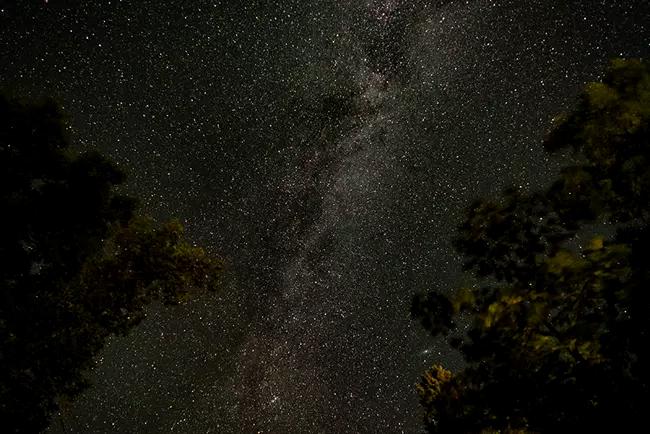Is it dark outside? Is the sky clear? If the answer to both those questions while visiting Voyageurs National Park in Minnesota is yes, then raise your eyes skyward and there’s a good chance you’ll view the dancing green, yellow, purple, and red lights of the Aurora Borealis (aka northern lights) overhead.

The Aurora Borealis, Voyageurs National Park / NPS - Lavoie
In addition to a clear night sky, this amazing display of night lights is impacted by the type of radiation produced by the sun as well as your location on the Earth. The Aurora Borealis shines sporadically over the middle and high latitudes of the northern hemisphere, and Voyageurs National Park is certainly in the right place for a northern lights sighting. Visit during the winter and your chances increase slightly because there are more hours of darkness.
The northern lights appear any time of the year, and they may be active all day long, even though you just see them at night. What causes this atmospheric phenomenon?
According to park staff:
The Earth is constantly being bombarded with debris, radiation, and other magnetic waves from space. Most of the time, the Earth's own magnetic field does an excellent job of deflecting these potentially harmful rays and particles.
When charged particles from the Sun encounter the Earth's magnetosphere, the particles are deflected by the magnetosphere's spiraling motion around the field lines. This deflection slows the particles streaming from the Sun, causing them to flow around the Earth like water in a stream being diverted by a rock.
Sometimes the particles penetrate the Earth's magnetosphere and collide with nitrogen and oxygen atoms in our atmosphere. This releases photon energy in the nitrogen and oxygen atoms, producing amazing aurora lights. The color of the aurora depends on which atom is struck, and the altitude of the collision.
- Green: oxygen, up to 150 miles in altitude
- Red: oxygen, above 150 miles in altitude
- Blue: nitrogen, up to 60 miles in altitude
- Purple: nitrogen, above 60 miles in altitude
When these constantly-shifting magnetic and electrical forces react with one another, the aurora appears to dance in the night sky.
Diagram of the origin for the Aurora Borealis / NASA
The northern lights will appear as streaks or cloud-like patches of light. Depending on their intensity, the lights might be just a patch or band on the northern horizon. At higher intensities the northern lights can fill the entire sky. The lights will usually be white or a pale green, but will sometimes appear in colors such as yellow, red, blue, or even purple.
If you're uncertain if that patch of light is indeed the northern lights, watch and be patient; the northern lights can disappear completely, only to regain their brightness minutes later. If the patch grows brighter, fades, then reappears, it is most likely the northern lights.
Where are some good spots from which to watch this natural light display?
According to park staff:
Find an open horizon facing north. The distance between Rainy Lake and other lakes to the south like Kabetogama, Namakan, and Sand Point is generally not significant enough to impact the visibility of the aurora, if it is active. A clear spot free of branches and a wide view of the horizon will give you a better vista in which to search for the lights. Some suggested viewing areas in the park are:
- Ash River Visitor Center grounds
- Meadwood Road Day Use Area
- Rainy Lake Visitor Center upper parking lot
If you are planning a visit to Voyageurs and want to try and see the lights, you can check NASA's sky calendar to learn when the moon will rise and how bright it will be during your trip. Moonless nights (new moon) are the best times to see the northern lights.
Even if the northern lights do not make an appearance, you can still enjoy the view of millions of starry pinpoints dotting the indigo sky. Voyageurs is a designated International Dark Sky Park, meaning there is little to no light pollution marring a fantastic view of the wide-open night sky above.

The Milky Way as seen from Voyageurs Forest Overlook, Voyageurs National Park / NPS file






